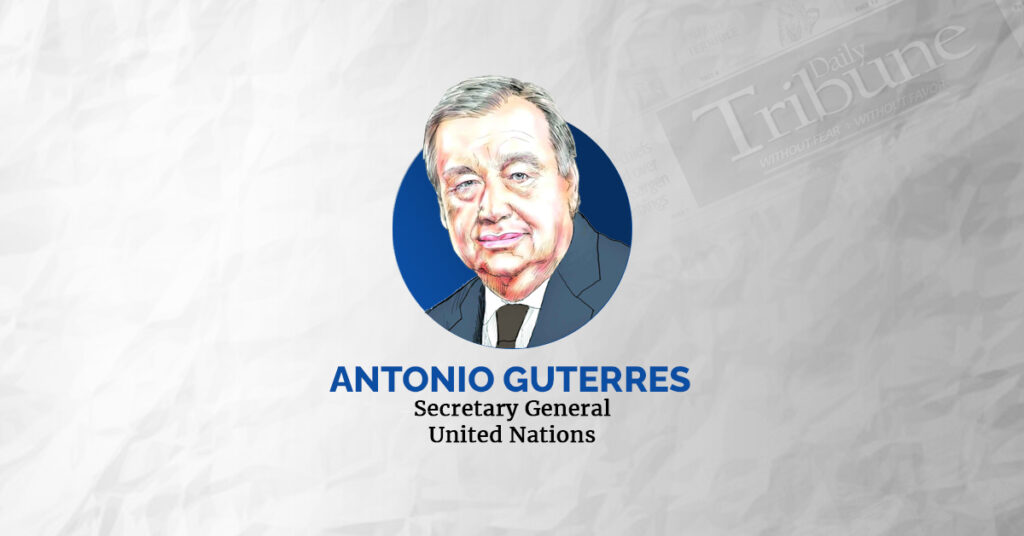I am dismayed to say that our world today is teeming with examples of the devastating relationship between hunger and conflict.
In Syria, almost 13 million people go to bed hungry after a decade of war and a horrendous earthquake. In Myanmar, conflict and political instability have thrown progress towards ending hunger into reverse. In Gaza, no one has enough to eat. Of the 700,000 hungriest people in the world, four in five inhabit that tiny strip of land.
In many places, climate disasters add another dimension. Every one of the 14 countries most at risk from climate change are suffering conflict. Thirteen of them face humanitarian crisis this year.
In Haiti, hurricanes combine with violence and lawlessness to create a humanitarian crisis for millions. In Ethiopia, drought comes hot on the heels of war. Almost 16 million people are estimated to require food assistance this year. And refugees from the conflict in neighboring Sudan are adding pressure on already scarce resources.
In the Sahel, rising temperatures are raising tensions: Drying-up water resources, wrecking grazing land, and ruining smallholder agriculture — the staple of local economies. Against a backdrop of longstanding political instability, conflict between farmers and herders is the result.
Meanwhile, globally, we risk a resurgence of food inflation as droughts sap the Panama Canal and violence hits the Red Sea — throwing supply chains into disarray.
Without action, the situation will deteriorate. Conflicts are multiplying. The climate crisis is set to spiral, as emissions continue to rise. And acute food insecurity has been increasing year on year. The World Food Program estimates that over 330 million people were affected in 2023. And it has warned of an acute deterioration in eighteen “hunger hotspots” early this year.
To avoid mounting threats to international peace and security, we must step in. And act now to break the deadly links between conflict, climate and food insecurity. First, all parties to all conflicts must abide by international humanitarian law. Far too often, this is not the case.
Security Council Resolution 2417 on the protection of civilians in armed conflict is clear: goods essential to civilians’ survival must be protected. Starvation of civilians may constitute a war crime. And humanitarians must have unimpeded access to civilians in need. This Council has a critical role in demanding compliance, and holding those who breach the resolution to account.
Second, we must fund humanitarian operations in full — to prevent disaster and conflict from feeding hunger. Last year, humanitarian operations were less than 40 percent funded. Around a third of the money for these operations was earmarked for tackling food insecurity.
Third, we must create the conditions to resolve conflict and preserve peace — within countries and between countries. Exclusion, inequalities and poverty all increase the risk of conflict.
Turbocharging progress towards the Sustainable Development Goals — including our goal of zero hunger — is the answer. We need massive investment in a just transformation to healthy, equitable and sustainable food systems. And we need governments, business and society working together to make such systems a reality.
Today we see a grotesque disparity between allocation and need — globally almost a third of food is wasted while hundreds of millions of people go to bed hungry every night. And food consumption, production and distribution are responsible for around a third of global greenhouse gas emissions. We must create food systems that feed the planet without wrecking the planet. That means aligning climate action and food systems transformation — as I called for at the UN Food System Stocktake last July — to help secure sustainable development, good livelihoods, and healthy people on a healthy planet. This requires working together, and bringing all people — women, young people and marginalized communities — into decision-making.
We must also build and finance social protection systems to protect livelihoods and ensure basic access to services and resources. And we must strengthen and renew global peace and security frameworks.
It is vital that we make the most of the Summit of the Future later this year, where Member States will consider the proposed New Agenda for Peace. This presents a comprehensive vision for peace in our changing world, based on prevention and international law, and anchored in human rights. And it recognizes the links between sustainable development, climate action, and peace.
Fourth, we must get a grip on the climate crisis to limit the rise in global temperature to 1.5 degrees Celsius. Because climate action is action for food security and action for peace.
G20 nations must lead a just global phaseout of fossil fuels, in line with the principle of common but differentiated responsibilities and respective capabilities, in the light of different national circumstances.
And all countries must create ambitious new national climate action plans — or nationally determined contributions — by 2025, that align with the 1.5-degree limit.
We must also get serious about adaptation: Ensuring every person on earth is protected by an early warning system by 2027, and that early warning leads to early action; And delivering adequate adaptation finance.
Developed countries must clarify how they will honor the promised $40 billion a year in adaptation finance by 2025. And they must show how the adaptation finance gap will be closed.
We also need substantial contributions to the new Loss and Damage Fund established at COP28.
And we need to support local institutions to take the lead in reducing disaster risk in their areas.
***
Excerpts of the Secretary-General’s remarks to the Security Council High-level Open Debate on the Impact of Climate Change and Food Insecurity on the Maintenance of Int’l Peace and Security, on 13 February 2024.
